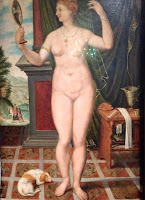WE HAVE COME A LONG WAY, HAVE WE NOT?
One of the things that really struck me when I arrived in Paris as a teenager, were the bodily smells. People did not shower, wash or bathe as we did in Australia. It’s difficult to believe that over the years when I was working, I needed to point out to certain members of my staff that it would be a good idea if they used a deodorant……I’m not joking as other product managers in the different groups couldn’t work with « the smell ». What must it have been like in the 16th century?
There were quite a few people in the exhibition but it was comfortable - in every way - as not one of those blockbusters which Paris is renowned for. The exhibition is « a petite perle ». There is something quite voluptuous, sensual and erotic about women « bathing » from the Renaissance onwards. Their bodies are round, veils are there to hide the over erotica and the cultural side of bathing, differs immensely from then, the 16th century to now.
 |
For many centuries, washing and dressing was an activity attended by servants, family, friends and visitors. Our modern insistance on total privacy is the result of a long process. Quite obviously observed by many painters.
Taking a bath during the period of the Renaissance was an exceptional event. The later middle ages did show a change for bath houses where men and women soaked in big wooden hot tubs. Doctors and moralists warned of the risks linked to the closeness of bodies. The dangers of contagion with the worst being the plague. It was only the Romans who cared for their bodies by going regularly to the baths. Here is a very familiar looking painting by an unidentified artists in the late 16th century. In those days it was not unusual to see the bath like a bed with curtains in rails.

In the 17th century it was called « The Dry Toilette ». Erasmus recommended that washing the face with cold water each morning, « was as clean as it was salubrious » But others drew attention to the "dangers of such practices. Washing with water impairs the sight, causes toothache and catarrh and makes the face pale and more prone to cold in the winter and tanning in summer ». A white cloth was used to « clean »the body. When I saw that this women was catching fleas and killing them off on her body, my body gave a little shiver.
Men could be seen in the bedchambers. Not exactly taking part in the toilet but if they had other activities when Madame was making herself beautiful and clean for him, they waited patiently.
By the 18th century, there were many libertine temptations. Manuals were now being printed with long passages on bodily cleanliness, the perquisite of good health. Washing now extended to the most secrets parts of the body and was done with a moistened cloth or sponge. Now it was accepted that those nasty bodily odors which had previously been hidden with perfumes, could be cleansed away with water.
 |
Bourgeois modesty returned in the 19th century. Soon I was to be back in a world of bathing which looked familiar. Steilen to begin with and let’s not forget Bonard. Soon we would go from the tub to the languishing in the bath tub.
In the 20th century it was hedonism and modernity. Running water was gradually introduced to most housing quarters. Even central heating was launched so we could undress and stay warm. (I might add that my grandmother did not introduce central heating into her home until the late 50’s. As children we suffered badly from the cold….or I did). The bathroom was now the perfect place fo new rituals. Make-up, skin care…..
I don’t know what the watch meant in Picasso’s painting, nor why his model is in a very cramped box….perhaps her gaze is not on her face, but elsewhere.
 |
 |
I loved this sculpture by Julio Gonzales (1931) «Woman Coming her hair ».(above left )
How different the early advertising was in praise of cosmetics. We have now moved from a very sensual description of bathing to something which is practically matter of fact. Look at this painting by Erro. It certainly embodies the Renaissance but placed in this age surrounded by astronauts in their space suits. A sign of virility? Certainly a sign of different epochs. 21st century advertising is much more product accentuated......
 |
and yet when I looked at this……
it goes to show just how beautiful « The Young Woman at Her Toilette » could be in the late 19th century. (Eugène Lomont - 1898).
 |
| (Eugène Lomont - 1898). |











Commentaires